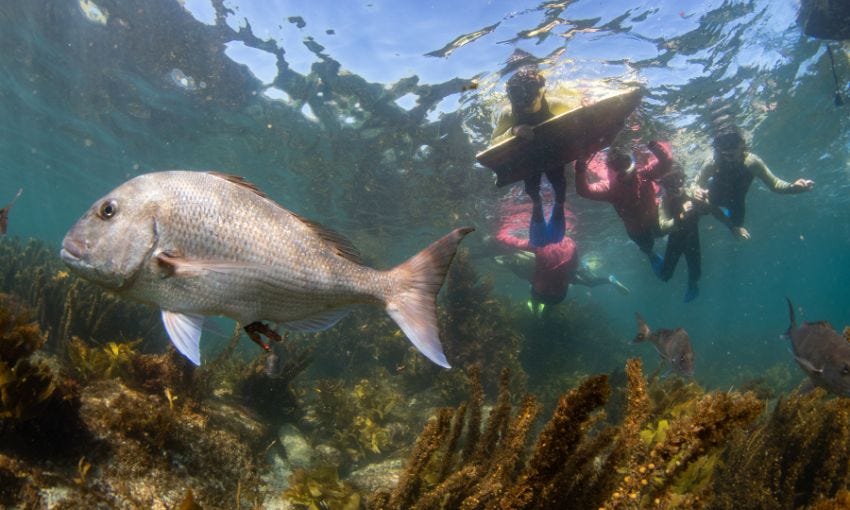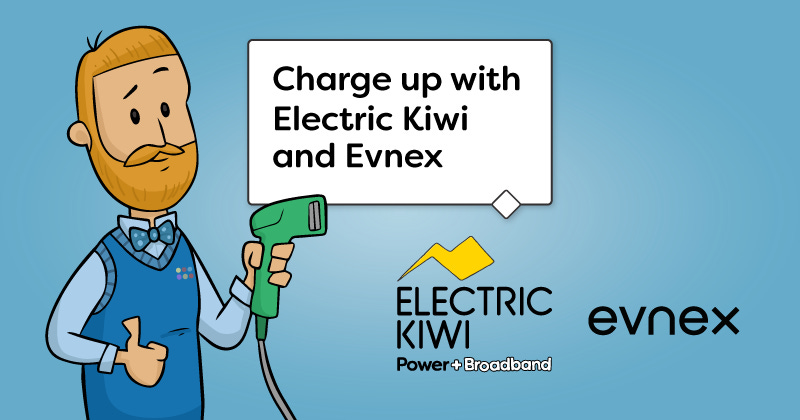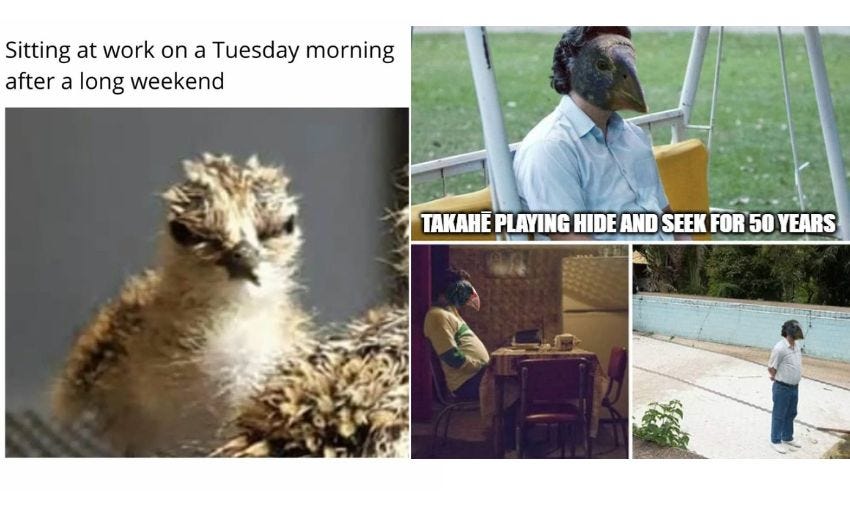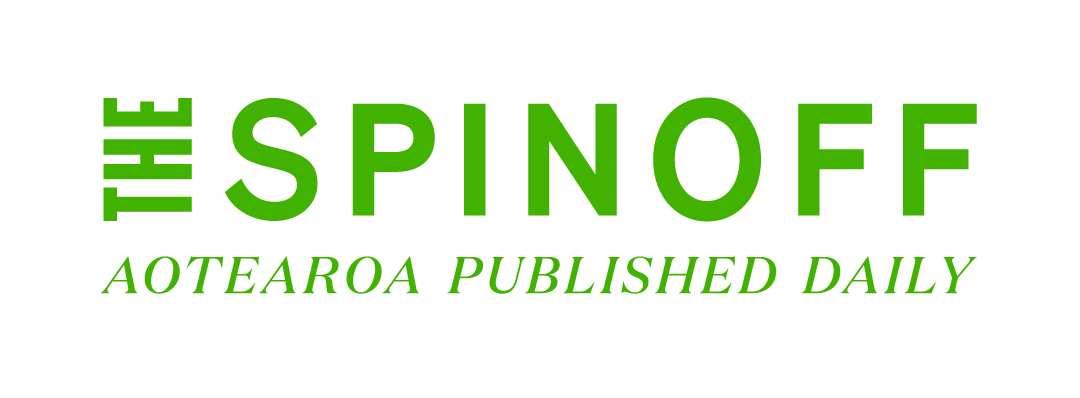Good news for the Gulf?
A proposal to beef up marine protection could be the lifeline the ailing Hauraki Gulf needs.
Kia ora and welcome to Future Proof, brought to you by Electric Kiwi.
Rangatahi enjoying the wonders of Cape Rodney-Okakari Point Marine Reserve north of Auckland. Image credit: Sophie Journee.
This past long weekend was a stunner – it finally feels like summer is just around the corner. Although I wasn’t quite brave enough for my first ocean dip of the season, I’m planning one of my first summer swims at Cape Rodney-Okakari Point Marine Reserve, New Zealand’s oldest no-take marine reserve, commonly known as Goat Island. I’ve been snorkelling here since I was little, kicking in the shallows with the big friendly snapper.
Marine reserves inspire rangatahi
It’s a special place for Wednesday Davis too. Davis is a marine educator and guide with Experiencing Marine Reserves, a national programme that gets kids into the ocean to learn about conservation. “[Goat Island] has some of the biggest snapper many of our participants have ever seen… Marine life flourishes in the protected area, and you can always see something interesting and exciting!” she says, referring to the reserve as a “wet library”. A recent highlight involved an encounter with bottlenose dolphins. “The dolphins were really curious and were swimming underneath the rangatahi, giving them an experience of a lifetime,” she says.
It’s the vibrancy of the underwater world at Goat Island that really hammers home the conservation message: “Seeing the difference between their local environment – often very degraded and polluted – and a protected environment inspires and shapes caring attitudes towards our ocean,” says Davis. Goat Island is a great example of what a nearshore environment in the Gulf is supposed to look like. The reality for most places in the Gulf is quite different.
Kina barrens and dead shellfish
The 2020 State of the Gulf report painted a dire picture of the marine environment on the doorstep of our biggest city: crayfish functionally extinct, sediment choking estuaries, mass mortalities of shellfish, kina barrens in place of healthy kelp and 22% of seabirds threatened with extinction, among many other confronting facts. But it’s not beyond hope – we just need some bold action to reset the balance. James Frankham of New Zealand Geographic wrote about fixing the Gulf back in 2020 (and he revisited the “tragedy of the commons” in our oceans in another article earlier this year).
One way to help fix the Hauraki Gulf
This summer, a pilot programme will see Ngāti Manuhiri vessels out on the Gulf, patrolling the rohe moana to ensure fishers are keeping within the rules. It’s one puzzle piece of a restored Gulf – but to complete the picture, we’re going to need more marine protection. Currently, just 0.3% of the Hauraki Gulf is protected in no-take marine reserves like Goat Island. Marine protection of all kinds sits at just over 6%. Marine protection can restore functioning ecosystems, and host up to seven times more fish abundance than unprotected areas.
Now, after a years-long hashing out of what can be done between government, mana whenua and other stakeholders, there’s a proposal to increase protection to around 18%. This includes 12 new high-protection areas (like marine reserves, but with some customary harvest), five new seafloor protection areas and two extensions to existing protected areas. The Department of Conservation is asking for feedback on this proposal now, and both Forest & Bird and Revive Our Gulf have set up click-and-send submissions.
The potential for more “wet libraries” is something Davis is keen to see. “With increased protection, the mauri of the Gulf, its taonga, and the people it connects can be restored and preserved for future generations,” she says. Sounds like cause for hope, I reckon.
Get a deal on your home EV charger with Electric Kiwi
New Zealand based company Evnex offers quick and affordable home EV charging. Pair their tech with Electric Kiwi’s MoveMaster plan, allowing you to charge your EV overnight with half price power (11pm - 7am), and you’ve got a sweet combo. As a MoveMaster customer you’ll receive $150 off Evnex’s standard price for an installed Smart EV Charger and have the option to pay off the rest on an interest free payment plan that can be added to your Electric Kiwi bill.
If you own an electric vehicle - or are considering buying one - check out the full details here.
Win-win: Fishing exclusion zone boosts tuna catch
Marine protected areas can help mobile fish populations like tuna recover, according to new research. The huge Papahānaumokuākea Marine National Monument in Hawai’i was extended to cover 1.5 million square kilometres in 2016, making it the biggest marine protected area on the planet. Since then, catch rates of two tuna species have increased in its vicinity, up to hundreds of kilometres away, in a win for both tuna populations and fishers. However, it’s unclear whether these results can be generalised – and in particular whether such spillover effects occur for smaller pockets of protection and different mobile species. (In the Hauraki Gulf, crayfish in marine reserves have been declining due to fishing effort along the reserve boundaries – the crays are too mobile and need bigger protected zones to hang out in!)
Say what!? We’re gonna feed nine billion people AND reduce greenhouse gas emissions?
“More protein, more sustainably, from more sources.” That’s what we need to chase to solve our food-climate conundrum, said experts at the Agri-Food-Tech conference. Nikki Mandow reports for Newsroom that by 2050, we’ll need to feed more than nine billion people while also drastically reducing our greenhouse gas emissions. So how can we do it? There’s a smorgasbord of options: lab-grown meat, precision fermentation, insects, seaweed, mixtures of funky legumes to mimic scrambled eggs.
The conference experts didn’t think the plant milk industry would disrupt traditional dairy, despite more and more people I know switching their coffee order to an oat milk latte. Speaking of plant milks, this neat piece from Chemical & Engineering News spills the tea on the complicated science behind deceptively simple plant milk products. (Also, the opening line amused me: “One of the ways that plants are distinct from mammals is that plants don’t have nipples. Despite this disadvantage, one can still get milk from a plant.” Brilliant.)
Recommended reading on pricing agricultural pollution
In the wake of the government’s He Waka Eke Noa proposal to set a price on agricultural carbon emissions, a handful of Groundswell protestors descended on Parliament last week to voice their displeasure over the plan (which was designed in partnership with industry). Stuff’s Olivia Wannan has done a great job fact-checking the protestors’ climate complaints. And Newsroom’s Marc Daalder has a thoughtful and detailed analysis of why pricing livestock pollution is reasonable and backed by evidence.
The world needs to be six times more ambitious
Summing up countries’ Nationally Determined Contributions (i.e. what they promise to do to reduce emissions under the Paris Agreement) leaves us with a massive shortfall to keep climate change in check. Current plans would cut 2019 carbon levels by 7% by 2030, but this needs to be 43% – six times greater – if we want to stick within 1.5 degrees of warming. These stark figures come ahead of Cop27, which is set to kick off in Egypt next month.
Also on the Cop27 agenda will be small island states’ demand for a “Loss and Damage Response Fund” for climate victims. Nations vulnerable to climate change first requested financial support to help them weather the climate storm more than 30 years ago, but were knocked back by wealthy countries wary of “endless liabilities”. Now, with extreme weather intensifying, the call for support will be even louder come 6 November.
Hector’s dolphins shift as ships cruise in
Nationally vulnerable Hector’s dolphins were less likely to be spotted in the inner Akaroa Harbour when cruise ship numbers increased, new research suggests. Meanwhile, Hector’s dolphins in nearby Lyttelton Harbour will have to contend with high-speed vessel traffic, as the SailGP (aka the Formula One of sailing) is set to take place in March next year. The race organisers say they have a “world-first” marine mammal protection plan lined up, but won’t release it in full as it constitutes “valued intellectual property”, David Williams reports for Newsroom.
Journalism is an essential part of society and shouldn’t be a privilege of those who can afford it. The support of readers like yourself helps to ensure The Spinoff remains freely accessible to all, regardless of their ability to pay. If you value what we do and have the means to do so, please make a donation today.
More stories:
Billions of Alaska’s snow crabs have disappeared in the last four years. This piece in The Guardian explores scientists’ theories for what happened – and yes, climate change comes into play.
Car manufacturer Volkswagen is facing legal action over its refusal to disclose lobbying activities that may contradict its public “championing of a green transition”.
A report commissioned by New Zealand’s four big electricity generators suggests investing $42b to reach 98% renewable energy by 2030, saying this would achieve emissions cuts faster than the plan proposed by the Climate Change Commission.
Greenpeace USA has released a damning report on the state of recycling in the US, calling the idea of a “circular plastic economy” both “a failed concept” and “a fiction”.
Access to natural spaces is linked to better health, and can help those in lower socioeconomic neighbourhoods close the lifespan gap, new research suggests.
This craft brewery sends less than 10kg of waste to landfill each week – less than the average Kiwi household.
Bird of the Year brings memes galore. Left: a kakī chick embodies my feels yesterday. Right: a representation of takahē playing ‘hide and seek’ in the Murchison Mountains, until they were rediscovered in 1948.
To finish this issue, it’s the final few days of voting for Bird of the Year / Te Manu Rongonui o te Tau, and I’ve been loving the continuing creativity – like this ~accurate~ reconstruction of a South Island kōkako, or this wrenegade rap. And of course the memes. We released an update late last week, with a super-close race between the top three of pīwauwau, kororā and kea. Who will swoop to victory? I don’t know – but I can assure you, it definitely won’t be a bat this time.
Kia pai tō wiki,
Ellen
Got some feedback about Future Proof or topics you’d like covered? Get in touch with me at futureproof@thespinoff.co.nz













